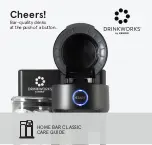
Premier VS Infrared Heating System
Page 18
June 04, 2014
CLEARANCE TO COMBUSTIBLES
A general clearance of 18” (0.5 m) in every direction
is required around each Burner, Vacuum Pump, and
End Vent Cap air supply (at the far end of each Radiant Branch) to ensure adequate air flow in and around the
Heating System.
In addition to this it is very important to observe the minimum clearance to combustibles at all times to
avoid any possibility of property damage or personal injury.
Clearances as marked on the heater body must be maintained from vehicles parked beneath. Signs should be
posted identifying any possible violation of the clearance distances from the heater in all vehicle areas.
Maximum allowable stacking height in storage areas should be identified with signs or appropriate markings
adjacent to the thermostat or in a conspicuous location.
Combustible materials are considered to be wood, compressed paper, plant fibres, plastic, Plexiglas or other
materials capable of being ignited and burned. Such materials shall be considered combustible even though
flame-proofed, fire-retardant treated or plastered.
The stated clearance to combustibles represents a surface temperature of 90°F (50°C) above room temperature.
Building materials with low heat tolerance
(such as plastics, vinyl siding, canvas, tri-ply, etc…)
may be
subject to degradation at lower temperatures.
It is the installer’s responsibility to assure that adjacent
materials are protected from degradation.
Table A lists the minimum clearance to combustible materials for various installation configurations. Note that
standard clearances also apply to installation above T-bar ceilings and above decorative grills. Additional
clearance may be required for glass, painted surfaces and other materials which may be damaged by radiant or
convective heat.
Note 1:
Bottom Shields are approved for all Burner sizes except the 250,000 BTU/hr model. The
“below” clearance (dimension C in Table A) may be reduced by 25% when an approved
Bottom Shield is used.
Note 2:
Reduced clearances downstream from the Burner are approved for all configurations.
Dimensions “B”, “C”, and “D” in Table A can be reduced for locations 25 ft (7.6 m) or
more downstream from a burner, before the next burner:
- For burner sizes up to 150,000 BTU/hr; maximum reduction 50%
- For burner sizes 155,000 to 250,000 BTU/hr; maximum reduction 40%
















































